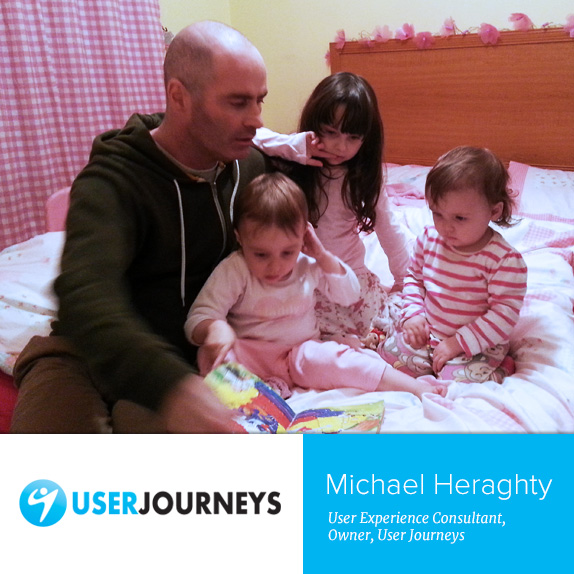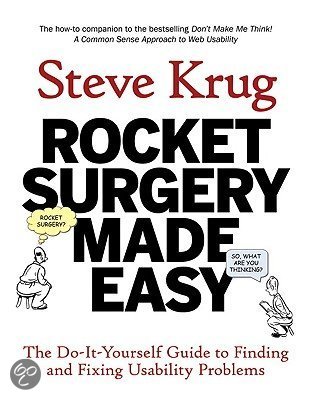Years ago, Michael Heraghty, UX Consultant and Owner of User Journeys sent us his first email. This had started it all: a long-term professional relationship built on mutual trust and unbridled passion for what we do. Michael is among one of our earliest clients which till this day we have always been glad to be in touch and work with.

I remove the clients’ fears; I reassure them.
Like many other Stampede clients, Michael is brimming with positivity. I was glad to be given the chance to have a chat with him about the first few years of User Journeys, his usability methods and what he believes in, amongst others.

Hi Michael, how are you? Thank you so much for spending time for this interview. Could you tell us more about yourself and User Journeys – probably from the inception of the company to where it is now?

Hi Zana! I’m good, thanks! How are you doing?
Well, to start – in the mid 1990s, I was a job-hopping media studies graduate. I took up designing websites as a hobby. During the dot-com boom, I got hired by a Dublin-based consulting firm, originally as a content editor for their internal website. Within six months, they sent me to Edinburgh, Los Angeles and New York. They put me in charge of user experience. I was thrown in at the deep end!
A couple of years later, I decided I want to work for myself. I set up my own internet consulting business. I learned as I went along, largely through my many mistakes. As the online industry matured, I was able to concentrate exclusively on usability and UX.
I also began to sub-contracts elements of the work to companies and individual freelancers around the world. This allowed me to nurture and grow User Journeys in a way I could not have imagined when I started out. It was an amazing experience.
Today, I have what could be described as a lifestyle business. I work hard, but I work when I choose to. I make time for my family. I can respectfully turn down client requests, if I need to.

That is an amazing journey, indeed!
So Michael, I read a bit through your website and your blog and was impressed by how User Journeys employs many different methods in analysing user experience in websites. We are always interested in these processes.
Could you walk us through some of them please?

Absolutely.
Often when companies engage us initially, they will ask for an expert usability review. This is where we spend time analysing a website for UX issues. We then meet the client for a workshop to give constructive feedback, suggesting improvements.
Contextual enquiry is one of my favourite research methods – this is where we go into an organisation, watch how they do things, and ask questions.
For example, once I had to redesign the interface of an internal web system used in a call centre. So I sat for a day with the call centre staff, listening in (with permission) to the incoming customer calls, observing how they entered information into the system, and what problems they encountered.
We also still rely heavily on the tried-and-trusted method of user testing. For anyone interested, I’d recommend Steve Krug’s book, Rocket Surgery Made Easy. He explains how to do user testing better than I ever could.

A/B testing is when we show one version of a web page to a group of users, and an alternative version to a second group, is another method I love. I find it works better on sites with strong traffic.

That book is definitely going into our to-read list. Thank you for that, Michael!
User experience has been inculcated based on design thinking many years ago. However it seems much more evident now and that seems to be what everyone talks about – empathy, storytelling etc. much more about putting yourself in your users’ shoes.
What do you think are the challenges in engaging clients from multiple backgrounds for usability testing and how did you solve it?

I regularly encounter organisational resistance to usability – what Jakob Nielsen the “usability intimidation barrier”. The way I overcome this challenge is to use lean or “discount” usability techniques – I try to get usability research done quickly and without fuss.
In other words, I try to remove the clients’ fears; reassure them.
The client thinks hiring a lab is going to be costly? We don’t need a lab. We can do the testing in the client’s office. It’s going to take too long? We can do it tomorrow morning and write the report in the afternoon. The client can’t get volunteers? I will get them. The volunteers can’t come to the office? We can do remote testing.

Love that part about reassuring the users. So over the years, how has the usability process changed or progressed based in your experience?

Well, the concept of usability has grown complicated by its amalgamation, in recent years, with the wider concept of user experience.
Usability advocates the user’s needs. When we speak about making an interface more usable, we mean putting the user’s interests first. User experience considers all of the users senses – not just whether they find something easy to use. Moreover, user experience can be manipulated. It is not always about putting the user first. Marketers can ask: “How can we create an experience X so that the user will buy product Y?”
Overall, though, it’s a great time to be working in UX. Clients have a far greater understanding of the role of UX practitioners now, and of the value we can bring. New tools like Balsamiq Mockups have made it easy to create rapid designs and prototypes. And we have so much user data now, thanks to apps like Google Analytics, which also lets you run advanced A/B tests.
With all these resources easily available, users are more educated and also more directly involved now.

So I heard that your first email to Stampede was about 8 years ago! That’s amazing.
How did you find out about Stampede and what brings you to the decision of engaging us for your work?

Yes!
I remember deciding I wanted to find an overseas designer. I had read about ‘outsourcing’ and wanted to try it. I looked at showcase websites such as webcreme.com and some designs stood out. One of them was by Stampede. I thought, “This is better than any design I could get from a local graphic artist.”
I got in touch with Shaza and the rest is history. With sites like Elance, working with other companies and individuals around the world seems so ordinary now, but back then it felt very new.

How has the experience been working with us so far?

Excellent. That’s why I keep coming back!
Stampede are part of what I consider my online village – even though, like many of the people I “know” professionally online, we only communicate through email and Skype.
In small communities, everyone would know their local greengrocer, or their doctor. I feel that level of familiarity and trust when I am working on a new project with Stampede. I am always delighted and honoured when they accept a new project – because, just like me, they have the right to say no.

You have no idea how happy this remark has made us, Michael. We love working with you too.
Thank you again from all of us at Stampede. We look forward to work for more exciting projects with you. See you around!

It has been a pleasure, Zana. Talk to you later!
A veteran of the Internet scene, Michael has published an e-book about SEO called “Website Findability” which you can download here.
On top of that, with close to 20 years of experience, Michael has worked on a huge number of exciting projects and has been giving lectures on usability/SEO for a number of institutions. You may find out more about Michael from his Twitter account and User Journeys website here.
